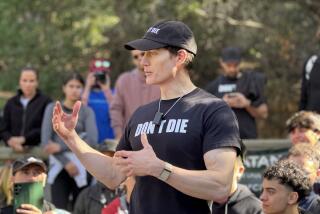James Hamblin explains dimpleplasty while touring with his book ‘If Our Bodies Could Talk’
“I read from the Death section at one of these [events] and it did not energize the room,” James Hamblin said Tuesday night to a small crowd at the Last Bookstore. The author of the new book “If Our Bodies Could Talk” — and host of the Atlantic’s popular video series of the same name — put his reading selection for the evening to a vote. What would it be: a passage about cosmetic dimple surgery, or the entry on Vitamin Water?
The room hesitates. “It’s graphic,” he says of the latter, and a few of the attendees, seated on folding chairs and squeezed together on The Last Bookstore’s vintage couches, perk up. “Dimples!” they call out. Hamblin seems delighted — it’s something of a local story, he offers — and begins.
Hamblin’s reading takes us on a brief, behind-the-scenes tour of a cosmetic surgery known as dimpleplasty, interviewing a pioneering Beverly Hills plastic surgeon, as well as a doctor in Pune, India. The word “suture” stands out for its repetition, as well as the phrase “splitting the muscle” and a sentence about “8 millimeter holes” being punched into someone’s cheek.The squeamish among us tune back in for Hamblin’s second reading — he circles back to Vitamin Water after all — in which he charts the rapper 50 cent’s lucrative sponsorship of the product. “Why is there Vitamin Water?” he opens, and then stops himself. “So yeah,” he says, “the book is all over the place.”
The “If Our Bodies Could Talk” video series offers “off-beat perspectives on health topics:” titles include “Crossfit vs Yoga: Choose a Side,” and “Sad Desk Lunch: Is This How You Want to Die?” Hamblin, who looks too young to have even held a job let alone made a career change, worked as a radiologist at UCLA before becoming a writer and senior editor at the Atlantic. While in Los Angeles, he also studied improv at the Upright Citizen’s Brigade, and his penchant for absurd humor seeps into his work.
Hamblin has garnered something of an internet following (Time Magazine featured his account in their Twitter 140 2014, and he was a finalist for the Best Web Personality Webby award in 2015) and the crowd that gathered for his book signing was largely sharply dressed people in their twenties and thirties. Ryan Thomason, who works in data, finds Hamblin’s research “cutting edge” and his tone “more approachable” than some medical writing; he was inspired to read the book after making veganism his new year’s resolution. Janet Guan, a development associate at the nonprofit Asian Americans Advancing Justice LA, is a fan of “scientific literary for laymen. Especially in this day and age,” she said, “any proliferation of knowledge” is welcome.
After the reading, Hamblin was joined by the book’s illustrator, Hallie Bateman. Soft-spoken, she said that she enjoyed the challenge of working on a medical text; her own work, and most editorial assignments, is “not anatomically correct.” She was inspired by middle-school text book drawings, and had to conduct her own research for accuracy. “I had no idea what the arteries in the leg looked like,” she admits. Hamblin writes about the funeral industry — “even at Walmart you can get a $5,000 coffin,” he says — and affordable alternatives, such as building a coffin for yourself. Bateman enjoyed this section in particular. Of a DIY coffin, “it could be pretty cathartic,” she says.
When, during the Q&A, a young man asks how Hamblin situates himself in the tradition of writer-doctors like Atul Gawande and others, he responds, “They write in a very traditional way that I hope to differ from enough to reach different audiences. This [book] is a lighter gloss.”
More to Read
Sign up for our Book Club newsletter
Get the latest news, events and more from the Los Angeles Times Book Club, and help us get L.A. reading and talking.
You may occasionally receive promotional content from the Los Angeles Times.








